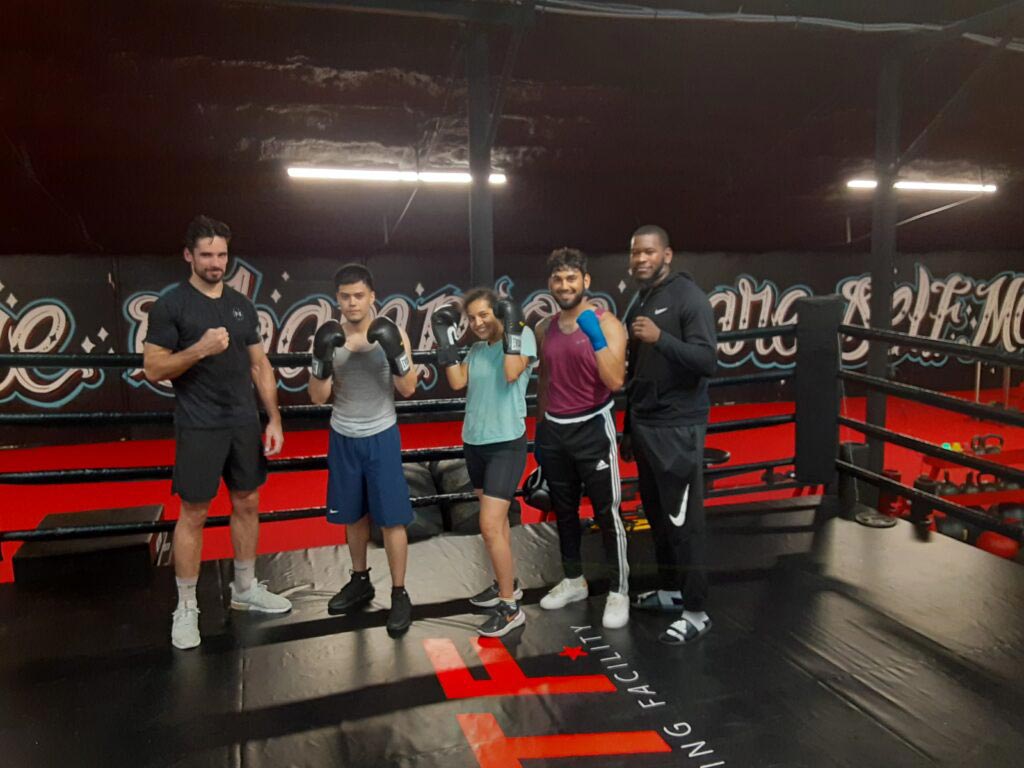About
The Dallas Fight Club Adult Recreational Boxing Program consists of the perfect 1-2 combination, that being Total Fun & Total Fitness. Better yet, it requires no prior boxing experience whatsoever. That’s because although boxers are amongst the world’s best conditioned athletes, you don’t have to be one to reap the innumerable benefits afforded by our multi-faceted workout sessions.
Provided simple to understand instructions in what is a genuinely supportive environment, a one of a kind coaching staff will guide you every step of the way as you learn to execute the skills and drills of the All-Time Greats to in no time at all obtain maximum enjoyment, as well as maximum health. Just know that anybody can punch but not everyone can dance so that we’ll teach you how to move with rhythm and grace. This during regimented class activities which induce weight loss, boost confidence, reduce stress, and elevate energy to overall improve strength, stamina, and cardiovascular fitness.
Free Trial Class
Ready to Rumble? Drop in for your free trial session today to gauge interest and suitability. Just fill out the Contact Us form below choosing one of the following class days and times listed to reserve a spot and it’s on. No equipment is necessary as we’ll provide training gloves during your initial visit if needed. Just bring water and a bit of attitude and at your own pace feel free to unleash the champion within we’ll be in your corner.
Schedule & Fees
Boxing/Crossfit Workout Sessions
Monday through Thursday 6-7am, 12-1 pm, 5-6pm, 6-7pm, 7-8pm
Friday 6-7am, 12-1pm, 5-6pm, 6-7pm
Saturday 10-11 am & 11am-12pm
Monthly Unlimited Classes $100
Drop-In Rate $20
6-Pack $100
12-Pack $180
Please note that 6 or 12 Pack Classes, ideal for those who choose to drop in randomly, must be redeemed within a 3 month period commencing from the Date of Purchase after which any remaining classes within the Pack become invalid.
Class Description
Classes feature traditional boxing & conditioning drills to on any given day include heavy bag work, double end or speed bag work, mitt training with coaches or students, varied calisthenics, as well as strength training whether done independently or as part of an interval structure. The strength portion consists of utilizing commercial grade weight equipment, free weights, kettlebells, medicine balls, TRX, stationary bikes, and several other pieces of total body conditioning apparatus to have you looking and feeling your absolute best.
Training Regimen
Program participants upon gym arrival start with 5 to10 minutes of warm-up activities which from day-to-day vary. Examples of warm-ups include rope jumping, jogging, dumbbell/medicine ball exercises, calisthenics, speed bag work, the stationary bike, and several other drills or exercises whether done solely or in combination.
Once warm-up is complete students then proceed to light flexibility stretching all parts of the body for approximately 5 minutes. This promotes injury prevention, improves reaction time and fluidity of movement, to finally increases range of motion and therefore dexterity and power.
The next phase of training depending on the daily routine in question could either involve shadowboxing, mirror or line drills, one-on-one punch mitt work with coaches or assigned partners, interval training and or circuit training at various stations whether it be the heavy or light bag station, floor or ring work.
Relating to the program itself it must be noted that curriculum activities whether attempted individually or with a classmate are to be accomplished in a progressive manner. This means that starting with the sport’s fundamentals students do not proceed to the more refined tasks until they’ve consistently demonstrated an ability to deploy the basic and or prerequisite skills.
Fundamentals include learning stance, directional footwork, and striking technique, initially to be done in concert with line drills. Such drills provide for the combining of punches, head movement, and footwork to develop balance in motion. Once proficient, group members then progress to shadowboxing, a consummate exercise which serves to enhance overall technique as well as one’s creativity and flow. Properly applied to light and heavy bags, acquired skill sets or sequential movements refined during the shadowboxing process allow individuals to obtain the best all-around workout possible.
With an initial emphasis on proper form to subsequently add speed and power, heavy bag workouts build strength and stamina, teaching recreational boxers how to put weight and leverage into their striking motion. Then there are the light bags to include air filled speed bags or double-end bags. These items are not only essential as concerns the development of rhythm and timing, but they ultimately increase one’s overall hand eye coordination so as to land the most accurate of blows.
In addition, because double end bags secured both at the top and bottom with an elastic cord strike back, individuals learn to employ a variety of defensive tactics which not only add to the scope of an already demanding endeavor, but such tactics will no doubt prove indispensable if ever confronted or put in a compromising position.
Once familiar with a beginning level workout routine participants are then introduced to interval training, an aspect which sees the periodic alternation between boxing drills and conditioning exercises. Maximizing one’s overall fitness level, interval training in addition burns serious calories, fosters breathing patterns, and promotes transition speed.
To further sharpen skills, increase energy capacity, and develop stellar hand, eye, and foot coordination, the utilization of punch mitts, punch paddles, and power shields are employed within a floor workout routine where clients work individually with accredited coaches, or with fellow classmates once taught how to properly utilize such equipment. From an athletic perspective such activities help to create more thoroughly well-rounded practitioners.
Upon effectively demonstrating skills on the above items, group members then commence to in tandem execute offensive and defensive maneuvers in predetermined sequences. Known as counter-punch drills, one student will at a gradual pace strike at the gloves of another and vice-versa to alternate back and forth so that this exercise not only resembles sparring, but these are in fact actual fight scenarios to be conducted under close supervision for safety. This is the most contact to be endured during what is considered a non-contact program.
As training sessions near conclusion, we then incorporate occasional wind-sprints as well as numerous calisthenic or plyometric strength and conditioning exercises using natural body weight and or varied equipment to develop explosiveness. This is followed by cool down and more thorough stretching with the best time to increase flexibility being towards the end of a workout when the body is totally loose.
Social Media
In order to help promote programming so as to benefit as large a sector of the community as possible we’ve taken to social media to get our message out.
Having said that, we maintain accounts with and regularly post content on Facebook, Instagram, X, and YouTube where via the latest in photo and video members of the general public can view our internal workings while regular training or special event updates are also made available on these very same platforms.
To connect to Facebook, Instagram, or X, just click on the icons located at the top of this or other web pages while to view our YouTube channel please Click Here.

